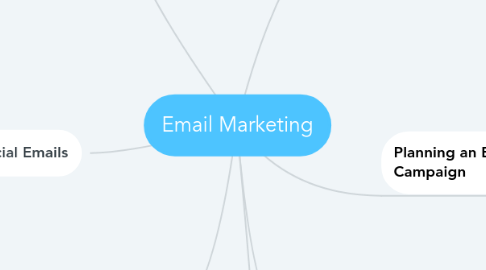
1. Benefits of an Email Marketing Campaign
1.1. Can deliver one of the highest returns on investment when compared to other eMarketing activities.
1.1.1. This is because it is highly cost effective due to a low cost per contact and is completely measurable.
1.2. Can be used as a tool for extremely efficient customer relationship management.
1.2.1. This is because it is highly targeted and customizable on a mass scale.
2. Types of Commercial Emails
2.1. Promotional Emails
2.1.1. These types of emails are direct and aimed towards enticing users to take immediate action, such as making a purchase. These are often designed around a main idea or goal.
2.2. Retention Based Emails
2.2.1. These often come in the form of newsletters or other sorts of informational email. They are focused on building a long term relationship with the users by providing information of value.
3. Other Ways Emails are Used in Marketing
3.1. Transactional Emails
3.1.1. Sent when purchases are made such as order confirmations, receipts, etc.
3.2. Spam
3.2.1. Unsolicited commercial or bulk email used to reach a substantial amount of potential consumers at little cost.
3.2.2. However, it is considered immoral as these emails are usually sent without permission of the recipient.
4. Personalization
4.1. Benefits of consumer personalization.
4.1.1. Even things as simple as the users name on an email has been seen to show improvements to ROI. Personalizing emails to specific users is simple since email allows one-to-one marketing on a macro scale. This builds customer loyalty and company reputation.
4.2. Ways to personalize emails for a consumer.
4.2.1. Sony's playstation weekly newsletter is a great example of how personalization can entice users to read them. They show statistics about your account at the bottom of all their newsletters which also show the sales that are being held that week, and new goods that are being released.
5. Analyzing and Using Results
5.1. Gather Data
5.1.1. Email marketers should gather data such as what users clicked on in which emails to show what their consumers prefer to see.
5.2. Analyze the Data
5.2.1. The marketers will then be able to effectively find what their user preferences are and adjust the content they send in their emails to better suit the consumers.
6. Privacy
6.1. Why it is important to respect customers privacy.
6.1.1. If customers feel that you are asking for too much information, they may be skeptical of cyber attacks, causing them to unsubscribe to your emails while hurting your reputation in the process. If a company sends emails without permission, they are sending spam which is heavily looked down on and hurts reputation.
6.2. How to respect consumer privacy.
6.2.1. It is important to have a very clear opt-in process, where users can give permission to the company for emails to be sent to them. Email marketers must also build up a solid relationship with users before asking for gradually more information over time.
7. Planning an Email Marketing Campaign
7.1. Defining Goals
7.1.1. These goals can be short term such as a user to making a purchase or requesting information. These goals can also be long term like return on investment.
7.2. Creating a list of Subscribers and Further Developing that List
7.2.1. It is important for an email campaign to have a database of all their subscribers information. In order to respect user privacy, information should be gathered over time once the one-to one relationship is stronger. They could start by gather the user's name and birthdate, and then later asking for zip-code and phone numbers.

